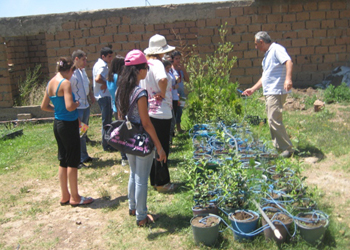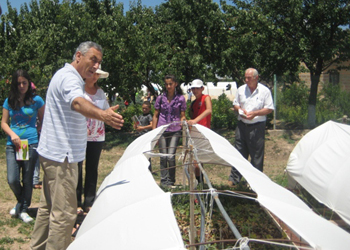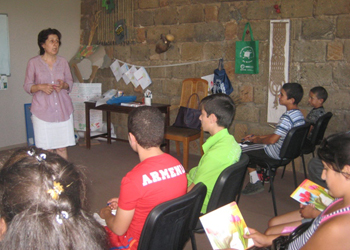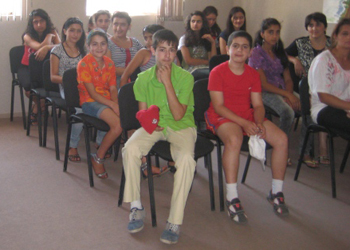 By Lusine Hayrapetyan | Development Principles NGO Expert | Heifer Armenia
By Lusine Hayrapetyan | Development Principles NGO Expert | Heifer Armenia
Translated by Emma Sargsyan | Media Coordinator | Heifer Armenia
Nature is our home: let’s keep it clean!
You can no longer surprise people with interesting facts or information. The internet has given everyone the opportunity to be informed, and at the same time has taken away the ability to carefully examine the things that surround us every day. We have no idea about the hidden properties of these things.
It is interesting to know that not far from us, and sometimes even by our side, there are huge “vacuum cleaners,” one acre of which is capable of absorbing from three to five tons of dust. During the year, they play host to a wonderful melody of sights and sounds. They help us maintain the quantity of the oxygen that we need and fill our lives with color.
Human beings are audience to the wonderful symphonic concert that birds, wind, lakes and rivers create for us. Later, the vacuum cleaners may transform to become paper, a matchbox or even a Christmas tree. Have you guessed what these vacuum cleaners are? The most important actors in the ecological chain: the forests.
These are the characteristics that the YES! Youth Club members gave to the forests during their visit to Karin nursery. This time about 30 young people from Lukashin, Mayisyan, Nalbandyan and Hushakert, together with their club trainers, visited the nursery with an interesting agenda, and an aim to carry out on-site research.
It was the first time they visited such a nursery. Most of them had about 10 trees to plant so they were busy taking care of the trees. To be able to make those “Factories of Oxygen” work, however, they had to not only attend class, but also carefully follow every piece of advice the experts gave them.
 During the visit the youth had the opportunity to attend a Tree Planting seminar conducted by prominent specialist and ecological educator Nvard Ghandilyan. She introduced to the youth the concept of cause and effect, asking them, “Can you imagine what could happen if all the trees suddenly disappeared?”
During the visit the youth had the opportunity to attend a Tree Planting seminar conducted by prominent specialist and ecological educator Nvard Ghandilyan. She introduced to the youth the concept of cause and effect, asking them, “Can you imagine what could happen if all the trees suddenly disappeared?”
This question was very effective to get the kids to understand how the whole ecosystem functions together. The youth had several ideas about a possible cause of trees disappearing: fires, tree-cutting, drought and natural disasters. The effects, or consequences, of the trees disappearing that the youth came up with included extinction of species of animals, destruction of the ozone layer, climate changes and spread of diseases.
Everyone was impressed with the answers from the youth. They were very active and had plenty of knowledge on this topic. After the seminar, the experts talked to the youth about alternative sources of energy and greenhouse gases, and it was quite clear that they were very aware of the ecological problems as well as possible solutions.
 Ghandilyan, the expert on the issue, asked the youth to be mindful about nature and use resources wisely. For instance, she said, one ton of paper means 17 trees, 8,000 gallons of water and 5,000 kilowatts of energy. She reminded the youth that electrical equipment switched off but left plugged in for 20 hours uses the same energy it takes for them to work for four hours. She also taught them the term ecological footprint, which is the amount of natural resources used.
Ghandilyan, the expert on the issue, asked the youth to be mindful about nature and use resources wisely. For instance, she said, one ton of paper means 17 trees, 8,000 gallons of water and 5,000 kilowatts of energy. She reminded the youth that electrical equipment switched off but left plugged in for 20 hours uses the same energy it takes for them to work for four hours. She also taught them the term ecological footprint, which is the amount of natural resources used.
The youth also met the director of the Karin and Khachpar nurseries, Rubik Ghandilyan. He showed them the diverse plants growing in the nursery and introduced the specifics of each species. The youth got acquainted to such species of plants as boxwood and barberry, and were given a short training on the pecularities of the care of the plants and the various types of plant vaccinations.
Zara Ozmanyan, a youth from the Mayisyan community, surprised everyone with her intelligent answers. Other children–Rafik and Lusine from Nalbandyan community, Argishti and Karen from Lukashin, Amalia, Kristine and Vardan from Hushakert–also demonstrated very good knowledge on ecological issues and were very actively answering the questions of the specialists.
 The youth club trainer from Nalbandyan village, Anahit Soghomonyan, had this to say about the visit: “I had a really good time here. I realized that each one of us is capable of changing a lot for the sake of friend and himself or herself.”
The youth club trainer from Nalbandyan village, Anahit Soghomonyan, had this to say about the visit: “I had a really good time here. I realized that each one of us is capable of changing a lot for the sake of friend and himself or herself.”
The last stop was the educational classroom at the nursery, where the huge bronze “Tree of Life” was waiting for the guests, who happily gathered under it for a group photo. After some treats and networking, the happy youth set off for their communities. They expressed willingness to revisit the nursery later, to see the now-little trees grown up and to get acquainted to the new species of plants.
Find out how you can help change lives in Armenia.